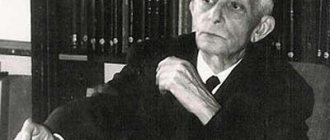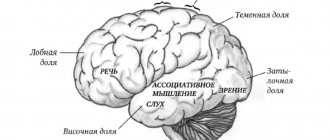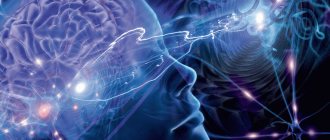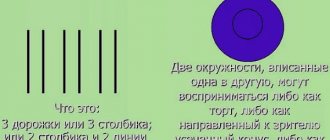“Tell me and I will forget. Show me and I will remember. Call me with you and I will understand.”
Confucius (ancient thinker and philosopher of China).
Perhaps everyone knows psychology as a system of life phenomena, but as a system of proven knowledge, few know it, and only those who specifically deal with it, solving all sorts of scientific and practical problems. The term “psychology” first appeared in scientific use in the 16th century, and denoted a special science that studied mental and mental phenomena. In the 17th – 19th centuries, the scope of research by psychologists expanded significantly and covered unconscious mental processes (the unconscious) and the detail of a person. And already from the 19th century. Psychology is an independent (experimental) field of scientific knowledge. Studying the psychology and behavior of people, scientists continue to look for their explanations, both in the biological nature of man and in his individual experience.
What is Gestalt psychology?
Gestalt psychology (German gestalt - image, form; gestalten - configuration) is one of the most interesting and popular trends in Western psychology, which arose during the period of open crisis in psychological science in the early 1920s. in Germany. The founder is the German psychologist Max Wertheimer
.
This direction was developed not only in the works of Max Wertheimer, but also of Kurt Lewin, Wolfgang Keller, Kurt Koffka and others. Gestalt psychology is a kind of protest against Wundt’s molecular program for psychology. Based on studies of visual perception, “ Gestalt
” configurations were derived (Gestalt is a holistic form), the essence of which is that a person tends to perceive the world around him in the form of ordered integral configurations, and not individual fragments of the world.
Gestalt psychology opposed the principle of dividing consciousness (structural psychology) into elements, and constructing complex mental phenomena from them according to the laws of creative synthesis. Even a peculiar law was formulated, which sounded as follows: “the whole is always greater than the sum of its parts.” Originally the subject
Gestalt psychology was a phenomenal field, later there was a fairly rapid expansion of this topic, and it began to include issues studying the problems of mental development; the founders of this direction were also concerned with the dynamics of personality needs, memory and creative thinking of a person.
The history of this psychological trend
The history of the development of the direction of Gestalt psychology dates back to 1912, when Max Wertheimer published his first scientific work on this topic. This work was based on the fact that Wertheimer questioned the generally accepted idea of the presence of separately existing elements in the process of perceiving something. Thanks to this, the 20s went down in history as the period of development of the school of Gestalt psychology. The main personalities who figured in the emergence of this trend:
- Max Wertheimer.
- Kurt Koffka.
- Wolfgang Köhler.
- Kurt Lewin.
These scientists made an invaluable contribution to the development of this area. However, more details about these representatives of Gestalt psychology will be discussed a little later. These people set themselves a difficult task. The first and main representatives of Gestalt psychology were those who wanted to transfer physical laws to psychological phenomena.
School of Gestalt Psychology
The school of Gestalt psychology traces its origins (ancestry) to the important experiment of the German psychologist Max Wertheimer - the “phi-phenomenon”
, the essence of which is as follows: M. Wertheimer, using special instruments - a strobe and a tachiostoscope, studied two stimuli in test people (two straight lines) by transmitting them different speeds. And I found out the following:
- If the interval is large, the subject perceives the lines sequentially
- Very short interval – lines are perceived simultaneously
- Optimal interval (about 60 milliseconds) – a perception of movement is created (the subject’s eyes observed the movement of a line “to the right” and “to the left”, and not two lines of data sequentially or simultaneously)
- At the optimal time interval - the subject perceived only pure movement (realized that there was movement, but without moving the line itself) - this phenomenon was called the “phi-phenomenon”.
Max Wertheimer outlined his observation in the article “Experimental studies of motion perception” - 1912.
Max Wertheimer -
famous German psychologist, founder of Gestalt psychology, became widely known for his experimental work in the field of thinking and perception. M. Wertheimer (1880 -1943) - born in Prague, received his primary education there, studied at universities - Prague, in Berlin with K. Stumpf; from O. Külpe - in Würzburg (received the degree of Doctor of Philosophy in 1904). In the summer of 1910 he moved to Frankfurt am Main, where he became interested in the perception of movement, thanks to which new principles of psychological explanation were later discovered.
His work attracted the attention of many prominent scientists of the time, among them was Kurt Koffka, who participated in Wertheimer's experiments as a test subject. Together, based on the results and the experimental research method, they formulated a completely new approach to explaining the perception of motion.
This is how Gestalt psychology was born. Gestalt psychology becomes popular in Berlin, where Werheimer returns in 1922. And in 1929 he was appointed professor in Frankfurt. 1933 - emigration to the USA (New York) - work at the New School for Social Research, here in October 1943 he dies. And in 1945 his book was published: “Productive Thinking”
, in which he experimentally explores the process of problem solving from the perspective of Gestalt psychology (the process of clarifying the functional meaning of individual parts in the structure of a problem situation is described).
Kurt Koffka (1886 – 1941) is rightfully considered the founder of Gestalt psychology. K. Koffka was born and grew up in Berlin, where he received his education at the local university. He was always especially fascinated by natural sciences and philosophy; K. Koffka was always very inventive. In 1909 he received his doctorate. In 1910, he fruitfully collaborated with Max Wertheimer at the University of Frankfurt. In his article: “Perception: An Introduction to Gestalt Theory,” he outlined the basics of Gestalt psychology, as well as the results of many studies.
In 1921, Koffka published the book “Fundamentals of Mental Development”
, dedicated to the formation of child psychology.
The book was very popular not only in Germany, but also in the United States. He was invited to America to give lectures at the universities of Cornell and Wisconsin. In 1927, he received a professorship at Smith College in Northampton, Massachusetts, where he worked until his death (until 1941). In 1933, Koffka published the book “Principles of Gestalt Psychology
,” which turned out to be too difficult to read, and therefore did not become the main and most complete guide to studying the new theory, as its author had hoped.
His research on the development of perception in children revealed the following: the child, as it turned out, actually has a set of not very adequate, vague images of the outside world. This prompted him to think that the combination of figure and background against which a given object is demonstrated plays an important role in the development of perception. He formulated one of the laws of perception, which was called “transduction”. This law proved that children do not perceive colors themselves, but their relationships.
Kurt Lewin and his dynamic psychological field theory
German and American psychologist Kurt Zadek Lewin (September 9, 1890 – February 12, 1947) studied the problems of personality, its needs, and the influence of social relations on it. In 1921 he became a teacher of psychology and philosophy at the University of Berlin. His views were based on the concept of Gestalt. He interpreted this concept as a field functioning as a single space in which individual elements are drawn towards it.
In 1926 he became a professor at the University of Berlin and taught there until 1933, because due to the mass repression of Jews he had to emigrate to America. In the article “Intentions, will and needs” (1926), he described experimental studies on needs and volitional actions. He considered aspiration – need – to be the basis of human activity in any form (action, memory, thinking).
In other words, his opinion was that a person’s personality lives and develops in the psychological field of the objects around it, each of which has a certain valence. For everyone it has its own sign, although there are those who repel or attract with the same force. Surrounding objects influence a person and thereby cause energy charges in him that cause tension.
When the balance between a person and a situation is disturbed, tension arises and the desire to take some purposeful action occurs. Lewin called this action a quasi-need. To satisfy your needs, you need to unwind. Discharge is carried out in a certain situation called a psychological field. Lewin created the “psychological field theory”, in which he explained human behavior [7]. In this regard, I investigated the problem of goal formation and goal-directed behavior.
Kurt also developed a theory of conflicts and identified three types:
| Conflict type | Definition | Example |
| "Aspiration - Aspiration" | The subject is between two positive approximately equal valences | A donkey dies of hunger while caught between two haystacks. |
| "Avoidance - Avoidance" | Subject between two almost equal negative valences | Punishment situation |
| "Striving - Avoidance" | One field vector comes from positive valence, the other from negative | A man wants to pet a dog, but is afraid |
In 1939, Kurt led the established group of researchers who studied the phenomenon of leadership. The effectiveness of the study was to identify three leadership styles: authoritarian, democratic and permissive. Moreover, he proved experimentally that it is the democratic one that brings the best results. In 1947 he participated in the creation of the scientific journal “Human Relations”.
Ideas, laws, principles
Key ideas of Gestalt psychology
The main thing that Gestalt psychology works with is consciousness. Consciousness is a dynamic whole where all elements interact with each other. A striking analogue: harmony of the whole organism - the human body works flawlessly and regularly for many years, consisting of a large number of organs and systems.
- Gestalt
is a unit of consciousness, an integral figurative structure. - The subject of
Gestalt psychology is consciousness, the understanding of which should be based on the principle of integrity. - The method
of cognition of gestalts is observation and description of the contents of one’s perception. Our perception does not come from sensations, since they do not exist in reality, but is a reflection of fluctuations in air pressure - the sensation of hearing. - Visual perception
is the leading mental process that determines the level of mental development. And an example of this: a huge amount of information obtained by people through the organs of vision. - Thinking
is not a set of skills formed through errors and trials, but a process of solving a problem, carried out through structuring the field, that is, through insight in the present.
Laws of Gestalt psychology
Law of figure and ground:
The figures are perceived by a person as a closed whole, but the background is perceived as something continuously extending behind the figure.
Law of Transposition:
The psyche reacts not to individual stimuli, but to their relationship. The meaning here is this: elements can be combined if there are at least some similar features, such as proximity or symmetry.
Law of Pregnancy
: There is a tendency to perceive the simplest and most stable figure of all possible perceptual alternatives.
Law of constancy:
everything strives for permanence.
Law of Proximity:
the tendency to combine elements adjacent in time and space into a coherent image. For all of us, as we know, it is easiest to combine similar items.
The law of closure
(filling in the gaps in a perceived figure):
when we observe something completely incomprehensible to us, our brain tries with all its might to transform, translate what we saw into an understanding accessible to us. Sometimes this even carries danger, because we begin to see something that is not in reality.
Gestalt principles
All of the above-mentioned properties of perception, be it figure, background or constants, certainly interact with each other, thereby carrying new properties. This is gestalt, the quality of form. Integrity of perception and orderliness are achieved thanks to the following principles:
- Proximity (everything nearby is perceived together);
- Similarity ( things that are similar in size, color or shape tend to be perceived together);
- Integrity (perception tends towards simplification and integrity);
- Closedness (the figure acquires a form);
- Contiguity ( proximity of stimuli in time and space. Contiguity can determine perception when one event causes another);
- Common area (Gestalt principles shape our everyday perceptions along with learning and past experience).
Gestalt - quality
The term “Gestalt quality” (German: Gestaltqualität) was introduced into psychological science X.
Ehrenfels to designate the holistic “gestalt” properties of certain formations of consciousness. The quality of “transpositivity”: the image of the whole remains, even if all the parts change in their material, and examples of this:
- different keys of the same melody,
- paintings by Picasso (for example, Picasso’s drawing “Cat”).
Constants of perception
Size constancy:
the perceived size of an object remains constant, regardless of changes in the size of its image on the retina.
Form constancy:
the perceived shape of an object is constant, even when the shape on the retina changes. It is enough to look at the page you are reading, first straight ahead, and then at an angle. Despite the change in the “picture” of the page, the perception of its shape remains unchanged.
Brightness constancy:
The brightness of the object is constant, even under changing lighting conditions. Naturally, subject to the same lighting of the object and the background.
Figure and ground
The simplest perception is formed by dividing visual sensations into an object - a figure
, located on
the background
. Brain cells, having received visual information (by looking at a figure), give a more active reaction than when looking at the background. This happens for the reason that the figure is always pushed forward, and the background, on the contrary, is pushed back, and the figure is also richer and brighter in content than the background.
The concept of insight according to Köhler
Experiments with chimpanzees allowed Wolfgang Köhler to understand that the task assigned to an animal is solved either by trial and error or through sudden awareness. Based on his experiments, W. Köhler made the following conclusion: objects that are in the animal’s field of perception and that are in no way connected with each other, in the process of solving a particular problem, begin to connect into some single structure, the vision of which helps to resolve the problem situation. This structuring occurs instantly; in other words, insight occurs, which means awareness.
To prove that a person solves certain problems in a similar way, that is, thanks to the phenomenon of insight, W. Köhler conducted a number of interesting experiments to study the thought process of children. He posed a task for the children similar to the one posed for the monkeys. For example, they were asked to get a toy that was high on the cabinet. At first, in their field of perception there was only a closet and a toy. Next, they paid attention to the ladder, chair, box and other objects, and realized that they could be used to get the toy. In this way, a gestalt was formed and it became possible to solve the problem.
W. Köhler believed that the initial understanding of the general picture, after some time, is replaced by a more detailed differentiation and on the basis of this a new gestalt, more adequate for a specific situation, is already formed.
Thus, W. Köhler defined insight as solving a problem based on capturing logical connections between stimuli or events [4].
Gestalt therapy
Gestalt therapy
- a direction of psychotherapy that was formed in the middle of the last century.
The term “gestalt” is a holistic image of a certain situation. The meaning of therapy: a person and everything around him are a single whole. The founder of Gestalt therapy is psychologist Friedrich Perls
. Contact and boundary are the two main concepts of this direction.
Contact
– the process of interaction between human needs and the capabilities of the environment. This means that a person’s needs will be satisfied only if he has contact with the outside world. For example: to satisfy the feeling of hunger, we need food.
The life of absolutely any person is endless gestalts, be they small or large events. A quarrel with a loved one, relationships with mom and dad, children, relatives, friendship, falling in love, talking with work colleagues - all these are gestalts. Gestalt can arise suddenly, at any time, whether we want it or not, but it arises as a result of the emergence of a need that requires immediate satisfaction. Gestalt tends to have a beginning and an end. It ends when satisfaction is achieved.
Gestalt therapy technique
The techniques used in Gestalt therapy are principles and games.
The most famous are the three games presented below for understanding yourself and the people around you. Games are built on internal dialogue, the dialogue is conducted between parts of one’s own personality (with one’s emotions - with fear, anxiety). To understand this, remember yourself when you experienced a feeling of fear or doubt - what happened to you.
Playing technique:
- To play you will need two chairs, they must be placed opposite each other. One chair is for an imaginary “participant” (your interlocutor), and the other chair is yours, that is, a specific participant in the game. Task: change chairs and at the same time play out the internal dialogue - try to identify yourself as much as possible with different parts of your personality.
- Making circles. A direct participant in the game must, going in a circle, address the fictional characters with questions that concern his soul: how the participants in the game evaluate him and what he himself feels for an imaginary group of people, for each person individually.
- Unfinished business. An unfinished gestalt always requires completion. And you can find out how to achieve this from the following sections of our article.
All Gestalt therapy comes down to completing unfinished business. Most people have many unsettled tasks and plans related to their relatives, parents or friends.
Unfinished Gestalt
It is a pity, of course, that a person’s desires are not always translated into reality, and in the language of philosophy: completing the cycle can take almost a lifetime. The ideal Gestalt cycle looks like this:
- The emergence of a need;
- Search for opportunities to satisfy it;
- Satisfaction;
- Leave contact.
But there are always some internal or external factors that hinder the ideal process. As a result, the cycle remains incomplete. In case of complete completion of the process, the gestalt is deposited in consciousness. If the process remains incomplete, it continues to exhaust the person throughout his life, while also delaying the fulfillment of all other desires. Often, incomplete gestalts cause malfunctions in the mechanisms that protect the human psyche from unnecessary overloads.
To complete unfinished gestalts, you can use the advice that the wonderful poet, playwright and writer Oscar Wilde gave to the world a hundred years ago:
“To overcome temptation, you need to... succumb to it.”
A completed gestalt certainly bears fruit - a person becomes pleasant, easy to communicate and begins to be easy for other people. People with incomplete gestalts always try to complete them in other situations and with other people - by forcibly imposing on them roles in the scenarios of their incomplete gestalts!
A small, simple, effective rule: start by completing the simplest and most obvious gestalt . Fulfill your cherished (preferably not serious) dream. Learn to dance tango. Draw nature outside the window. Take a parachute jump.
Basic provisions
Based on the principles, the main provisions can be described as follows:
- All processes of psychology are integral processes that have their own structure, which has its own set of specific elements that will always be secondary in relation to it. Based on this, the subject of Gestalt psychology is consciousness, which has a structure filled with closely related elements.
- Perception has such a feature as constancy. This suggests that the constancy of perception is the relative invariance of certain properties that objects possess (in the presence of changes in the conditions of perception). For example, this could be constancy of lighting or color.
Gestalt exercises
Gestalt therapy represents general therapeutic principles that help “oneself” learn to understand the mysterious labyrinths of one’s soul and recognize the sources of the causes of internal contradiction.
The following exercises are aimed at: simultaneous awareness of oneself and the existence of another. In general, they encourage us to step beyond the limits of the possible. When performing exercises, try to analyze what you are doing, why and how you are doing it. The main goal of these exercises is to develop the ability to find your own estimates.
Exercise – “Presence”
Goal: Focus on the feeling of presence.
- close your eyes
- Concentrate on your bodily sensations. If necessary, correct your posture
- Be natural every moment
- Open your eyes, relax them, remaining frozen in body and thoughts.
- Let your body relax
- Concentrate on the feeling of “being” (feel “I am here”)
After concentrating on the sense of I for some time, with your mind relaxed and silent, bring your breath into awareness and move your attention from “I” to “here”, and mentally repeat “I am here” simultaneously with inhalation, pause, exhalation .
Exercise – Feeling “You”
The purpose of the exercise: to be able to experience the state of presence “in another person”, that is, to be able to feel the state of “You” instead of the state of “Ego”. The exercise is performed in pairs.
- Face each other
- Close your eyes, take the most comfortable poses.
- Wait for a state of complete peace.
- Open your eyes
- Start having a wordless dialogue with your partner
- Forget about yourself, focus only on the person looking at you.
H. Exercise “I/You”
The exercise is also performed in pairs, you need to sit opposite each other.
- Concentrate;
- Eyes should be open;
- Maintain mental silence, physical relaxation;
- Concentrate on both the sensations “I” and “You”;
- Try to feel the “cosmic depth”, infinity.
The purpose of the exercise is to achieve the state: “I” - “YOU” - “Infinity”.
Methods of working with witnesses
Thanks to his research, Max Wertheimer developed in detail methods for determining the authenticity of witness testimony:
- The association method involves the subject's reaction to the proposed words. He must respond with a word that comes to his mind, as an association to what is proposed.
- The reproduction method consists of using a memorization text that contains information similar to the hidden facts, similar to the hidden facts and having nothing to do with the hidden facts. Over time, the test subject will make mistakes when reproducing the text.
- Method of associative questions. The study is based on a special list of guiding questions. In the process of finding answers to them, there will be ones that will lead to a solution to the problem.
- Method of perception. It is based on recognizing the type of person depending on his representative systems: visual, auditory, kinesthetic and digital. Next, work with a person in the key of his representative system.
- The distraction method includes many options, including deception, shock, and excessive flow of distracting information.
Gestalt pictures
Changeling drawings (visual illusions): What do you see? What emotions are conveyed on each side of the pictures? It is not recommended to allow preschool children to view such pictures, as they can cause mental disorders. Below are the famous “dual” images: people, animals, nature. What could you see in each of the drawings?
In addition, the idea of Gestalt psychology underlies such pictures, which are called “doodles”. Read more about droodles on this page.
With this article we wanted to awaken in each of you the desire to turn to yourself, to know the depth of your soul, to begin to take care of yourself - to open up to the world. Gestalt, of course, cannot make you richer, but it certainly can make you happier.
Introduction to the works of Spinoza
Wertheimer became acquainted with the social and philosophical thought of his maternal grandfather Jakob Zwicker, who was so pleased with his grandson's maturity that on his tenth birthday he gave him some of Spinoza's works. Max Wertheimer's complete absorption in a book given by his grandfather led his parents to limit his reading. This did not stop him from reading Spinoza in secret, taking advantage of the kindness of the maid, who hid the book from her parents in her chest. Spinoza was not something new; he influenced Wertheimer for life.
Reviews and comments
Dear friends, we will be very grateful to you for your opinions and for your activity. Share what you read and see, leave your reviews and comments below.
We also recommend reading:
- Storytelling
- The Lachins effect, or the Past Experience Barrier
- Where to start studying psychology
- Psychology: pseudoscience or not?
- Scientific knowledge: basics
- What will Asch's experiments teach society?
- Wundt's method of studying psychology
- Criminal psychology
- Theories of thinking
- Psycholinguistics as a tool for in-depth study of speech and language
- Cognitive psychology and cognitive psychotherapy
Key words:1Psychoregulation
Doctoral studies
His doctoral research included the invention of lie detectors, which he used as an objective way to examine evidence. Another aspect of his work was the collocation method, which he created before C. J. Jung developed it as a diagnostic method.
Because Max Wertheimer was financially independent, he did not need to hold any academic position and could devote himself to independent research in Prague, Berlin and Vienna. He continued his work related to the reliability of eyewitness testimony, and also at the neuropsychiatric clinic of the University of Vienna worked with the anamnesis of patients with speech disorders and those who had impaired reading, with damage to various parts of the left hemisphere cortex. He developed new diagnostic methods that showed that speech impairment is associated with a loss of the ability to perceive ambiguous and complex visual structures. This work provides a link between Gestalt psychology and the theory of neurologists Ademar Gelb and Kurt Goldstein.
Examples of some principles
A clear example of the above can be any graphic image in which a geometric figure is drawn not with one continuous line, but with many small segments. A person will immediately see the figure and only then distinguish its constituent segments. This is an example of the principle of closure. Graphically, you can represent any of the basic principles in this area of psychology.
The zone of general perception can well be illustrated by any ordinary situation. Let's say a person uses public transport every day. He rides a red tram. Arriving at the stop, he will be waiting for the red tram. If a blue or green carriage arrives, a person will feel confused and begin to look for a sign with a numbered route designation, although he will sit in the red one immediately without looking at it.










